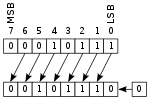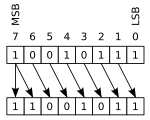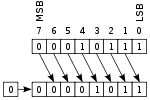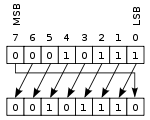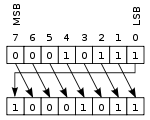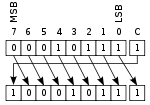
In computer programming, an arithmetic shift is a shift operator, sometimes termed a signed shift. The two basic types are the arithmetic left shift and the arithmetic right shift. For binary numbers it is a bitwise operation that shifts all of the bits of its operand; every bit in the operand is simply moved a given number of bit positions, and the vacant bit-positions are filled in. Instead of being filled with all 0s, as in logical shift, when shifting to the right, the leftmost bit is replicated to fill in all the vacant positions.

A triangular wave or triangle wave is a non-sinusoidal waveform named for its triangular shape. It is a periodic, piecewise linear, continuous real function.

Exclusive or, exclusive disjunction, exclusive alternation, logical non-equivalence, or logical inequality is a logical operator whose negation is the logical biconditional. With two inputs, XOR is true if and only if the inputs differ. With multiple inputs, XOR is true if and only if the number of true inputs is odd.
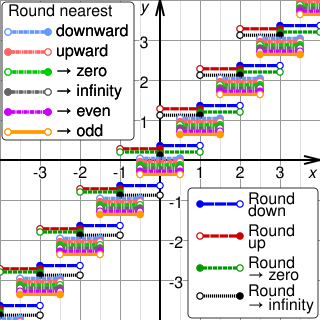
Rounding or rounding off means replacing a number with an approximate value that has a shorter, simpler, or more explicit representation. For example, replacing $23.4476 with $23.45, the fraction 312/937 with 1/3, or the expression √2 with 1.414.
A binary number is a number expressed in the base-2 numeral system or binary numeral system, a method of mathematical expression which uses only two symbols: typically "0" (zero) and "1" (one).
Two's complement is the most common method of representing signed integers on computers, and more generally, fixed point binary values. Two's complement uses the binary digit with the greatest place value as the sign to indicate whether the binary number is positive or negative. When the most significant bit is 1, the number is signed as negative; and when the most significant bit is 0 the number is signed as positive.
This is a list of operators in the C and C++ programming languages. All the operators listed exist in C++; the column "Included in C", states whether an operator is also present in C. Note that C does not support operator overloading.

The Doomsday rule, Doomsday algorithm or Doomsday method is an algorithm of determination of the day of the week for a given date. It provides a perpetual calendar because the Gregorian calendar moves in cycles of 400 years. The algorithm for mental calculation was devised by John Conway in 1973, drawing inspiration from Lewis Carroll's perpetual calendar algorithm. It takes advantage of each year having a certain day of the week upon which certain easy-to-remember dates, called the doomsdays, fall; for example, the last day of February, 4/4, 6/6, 8/8, 10/10, and 12/12 all occur on the same day of the week in any year.
In number theory, the integer square root (isqrt) of a non-negative integer n is the non-negative integer m which is the greatest integer less than or equal to the square root of n,
Zeller's congruence is an algorithm devised by Christian Zeller in the 19th century to calculate the day of the week for any Julian or Gregorian calendar date. It can be considered to be based on the conversion between Julian day and the calendar date.
In computing, the modulo operation returns the remainder or signed remainder of a division, after one number is divided by another.

In computer science and mathematics, the Josephus problem is a theoretical problem related to a certain counting-out game. Such games are used to pick out a person from a group, e.g. eeny, meeny, miny, moe.
In computer science, a logical shift is a bitwise operation that shifts all the bits of its operand. The two base variants are the logical left shift and the logical right shift. This is further modulated by the number of bit positions a given value shall be shifted, such as shift left by 1 or shift right by n. Unlike an arithmetic shift, a logical shift does not preserve a number's sign bit or distinguish a number's exponent from its significand (mantissa); every bit in the operand is simply moved a given number of bit positions, and the vacant bit-positions are filled, usually with zeros, and possibly ones.
Bit manipulation is the act of algorithmically manipulating bits or other pieces of data shorter than a word. Computer programming tasks that require bit manipulation include low-level device control, error detection and correction algorithms, data compression, encryption algorithms, and optimization. For most other tasks, modern programming languages allow the programmer to work directly with abstractions instead of bits that represent those abstractions.
In mathematics and computing, universal hashing refers to selecting a hash function at random from a family of hash functions with a certain mathematical property. This guarantees a low number of collisions in expectation, even if the data is chosen by an adversary. Many universal families are known, and their evaluation is often very efficient. Universal hashing has numerous uses in computer science, for example in implementations of hash tables, randomized algorithms, and cryptography.
In computer processors, the overflow flag is usually a single bit in a system status register used to indicate when an arithmetic overflow has occurred in an operation, indicating that the signed two's-complement result would not fit in the number of bits used for the result. Some architectures may be configured to automatically generate an exception on an operation resulting in overflow.
In computer science, multiply-with-carry (MWC) is a method invented by George Marsaglia for generating sequences of random integers based on an initial set from two to many thousands of randomly chosen seed values. The main advantages of the MWC method are that it invokes simple computer integer arithmetic and leads to very fast generation of sequences of random numbers with immense periods, ranging from around to .
In modular arithmetic, Barrett reduction is a reduction algorithm introduced in 1986 by P.D. Barrett.

In computing, an arithmetic logic unit (ALU) is a combinational digital circuit that performs arithmetic and bitwise operations on integer binary numbers. This is in contrast to a floating-point unit (FPU), which operates on floating point numbers. It is a fundamental building block of many types of computing circuits, including the central processing unit (CPU) of computers, FPUs, and graphics processing units (GPUs).
In the C programming language, operations can be performed on a bit level using bitwise operators.







